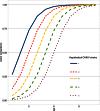Bridging the Gap Between Experimental Data and Model Parameterization for Chikungunya Virus Transmission Predictions
- PMID: 27920175
- PMCID: PMC5137240
- DOI: 10.1093/infdis/jiw283
Bridging the Gap Between Experimental Data and Model Parameterization for Chikungunya Virus Transmission Predictions
Abstract
Chikungunya virus (CHIKV) has experienced 2 major expansion events in the last decade. The most recently emerged sublineage (ECSA-V) was shown to have increased efficiency in a historically secondary vector, Aedes albopictus, leading to speculation that this was a major factor in expansion. Subsequently, a number of experimental studies focused on the vector competence of CHIKV, as well as transmission modeling efforts. Mathematical models have used these data to inform their own investigations, but some have incorrectly parameterized the extrinsic incubation period (EIP) of the mosquitoes, using vector competence data. Vector competence and EIP are part of the same process but are not often correctly reported together. Thus, the way these metrics are used for model parameterization can be problematic. We offer suggestions for bridging this gap for the purpose of standardization of reporting and to promote appropriate use of experimental data in modeling efforts.
Keywords: Aedes aegypti; Aedes albopictus; Chikungunya; arbovirus; basic reproductive number; data; extrinsic incubation period; mathematical modeling; vector competence; vectorial capacity.
© The Author 2016. Published by Oxford University Press for the Infectious Diseases Society of America. All rights reserved. For permissions, e-mail journals.permissions@oup.com.
Figures



Similar articles
-
Invasiveness of Aedes aegypti and Aedes albopictus and Vectorial Capacity for Chikungunya Virus.J Infect Dis. 2016 Dec 15;214(suppl 5):S453-S458. doi: 10.1093/infdis/jiw285. J Infect Dis. 2016. PMID: 27920173 Free PMC article. Review.
-
The native European Aedes geniculatus mosquito species can transmit chikungunya virus.Emerg Microbes Infect. 2019;8(1):962-972. doi: 10.1080/22221751.2019.1634489. Emerg Microbes Infect. 2019. PMID: 31259662 Free PMC article.
-
Potential of Aedes aegypti and Aedes albopictus populations in the Central African Republic to transmit enzootic chikungunya virus strains.Parasit Vectors. 2017 Mar 27;10(1):164. doi: 10.1186/s13071-017-2101-0. Parasit Vectors. 2017. PMID: 28347325 Free PMC article.
-
High vector competence for chikungunya virus but heavily reduced locomotor activity of Aedes albopictus from Germany at low temperatures.Parasit Vectors. 2024 Dec 4;17(1):502. doi: 10.1186/s13071-024-06594-x. Parasit Vectors. 2024. PMID: 39633401 Free PMC article.
-
Perspectives and Challenges in Entomological Risk Assessment and Vector Control of Chikungunya.J Infect Dis. 2016 Dec 15;214(suppl 5):S459-S465. doi: 10.1093/infdis/jiw397. J Infect Dis. 2016. PMID: 27920174 Review.
Cited by
-
Age-structured vectorial capacity reveals timing, not magnitude of within-mosquito dynamics is critical for arbovirus fitness assessment.Parasit Vectors. 2020 Jun 15;13(1):310. doi: 10.1186/s13071-020-04181-4. Parasit Vectors. 2020. PMID: 32539759 Free PMC article.
-
A Method for Repeated, Longitudinal Sampling of Individual Aedes aegypti for Transmission Potential of Arboviruses.Insects. 2021 Mar 27;12(4):292. doi: 10.3390/insects12040292. Insects. 2021. PMID: 33801709 Free PMC article.
-
Temperature impacts on dengue emergence in the United States: Investigating the role of seasonality and climate change.Epidemics. 2019 Sep;28:100344. doi: 10.1016/j.epidem.2019.05.003. Epub 2019 Jun 5. Epidemics. 2019. PMID: 31175008 Free PMC article.
-
Identifying Knowledge Gaps through the Systematic Review of Temperature-Driven Variability in the Competence of Aedes aegypti and Ae. albopictus for Chikungunya Virus.Pathogens. 2023 Nov 18;12(11):1368. doi: 10.3390/pathogens12111368. Pathogens. 2023. PMID: 38003832 Free PMC article.
-
Colonized Sabethes cyaneus, a Sylvatic New World Mosquito Species, Shows a Low Vector Competence for Zika Virus Relative to Aedes aegypti.Viruses. 2018 Aug 16;10(8):434. doi: 10.3390/v10080434. Viruses. 2018. PMID: 30115888 Free PMC article.
References
MeSH terms
Grants and funding
LinkOut - more resources
Full Text Sources
Other Literature Sources
Medical
Miscellaneous

